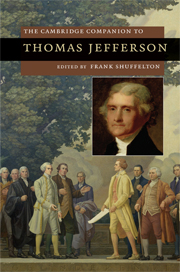Book contents
- Frontmatter
- Introduction
- 1 The Declaration of Independence and the new nation
- 2 Jefferson’s conception of republican government
- 3 Notes on the State of Virginia and the Jeffersonian West
- 4 Jefferson and Native Americans: policy and archive
- 5 Race and slavery in the era of Jefferson
- 6 Jefferson’s people: slavery at Monticello
- 7 Jefferson, science, and the Enlightenment
- 8 Thomas Jefferson and the creation of the American architectural image
- 9 The politics of pedagogy: Thomas Jefferson and the education of a democratic citizenry
- 10 Jefferson and religion: private belief, public policy
- 11 Jefferson and the language of friendship
- 12 Jefferson and Adams: friendship and the power of the letter
- 13 The resonance of minds: Thomas Jefferson and James Madison in the republic of letters
- 14 Jefferson and the democratic future
- Further reading
- Index
7 - Jefferson, science, and the Enlightenment
Published online by Cambridge University Press: 28 May 2009
- Frontmatter
- Introduction
- 1 The Declaration of Independence and the new nation
- 2 Jefferson’s conception of republican government
- 3 Notes on the State of Virginia and the Jeffersonian West
- 4 Jefferson and Native Americans: policy and archive
- 5 Race and slavery in the era of Jefferson
- 6 Jefferson’s people: slavery at Monticello
- 7 Jefferson, science, and the Enlightenment
- 8 Thomas Jefferson and the creation of the American architectural image
- 9 The politics of pedagogy: Thomas Jefferson and the education of a democratic citizenry
- 10 Jefferson and religion: private belief, public policy
- 11 Jefferson and the language of friendship
- 12 Jefferson and Adams: friendship and the power of the letter
- 13 The resonance of minds: Thomas Jefferson and James Madison in the republic of letters
- 14 Jefferson and the democratic future
- Further reading
- Index
Summary
A visitor to the White House in the summer of 1808 might have found the president in the East Room, studying a large collection of fossil bones spread out on the floor. Jefferson, president at that time of the American Philosophical Society as well as the United States, had long been interested in bones of the American “mammoth” and other fossil remains, for he was an avid student of all aspects of natural history. The evidence of natural history was, for example, the basis of Jefferson's famous dispute with one of the most prominent scientists of his day, Georges-Louis Leclerc, Comte de Buffon. Buffon claimed that American nature was inferior - specifically, that the New World produced fewer kinds of large quadrupeds than did the Old World, that these were less robust than their Old World analogues, and that Old World animals imported to the New World degenerated. Such claims about the supposed inferiority of American nature, Jefferson felt, had important implications for American culture and the future of the republican project. Jefferson opened the dispute with Buffon with a discussion of fossil remains of the mammoth in Notes on the State of Virginia and continued it in a scientific paper on fossils published in 1799 in the American Philosophical Society's Transactions. This paper, an account of bones discovered in a cave in Greenbrier County (now West Virginia), attempted the preliminary reconstruction of an animal, apparently previously undescribed, that Jefferson named the Megalonyx (“Great Claw”). Jefferson continued to pursue his study of fossils and, in 1807, he employed William Clark (of Lewis and Clark fame) to excavate Big Bone Lick (a mineral spring in Kentucky rich in late Pleistocene fossils) and to ship the bones to Washington.
- Type
- Chapter
- Information
- The Cambridge Companion to Thomas Jefferson , pp. 101 - 113Publisher: Cambridge University PressPrint publication year: 2009
- 2
- Cited by



